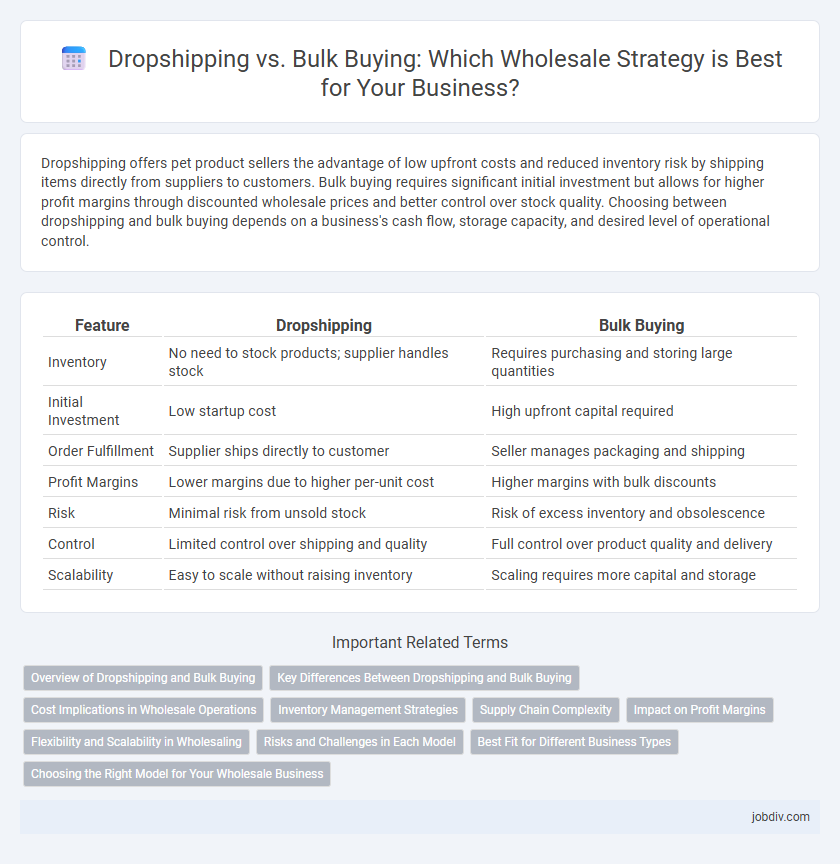Dropshipping offers pet product sellers the advantage of low upfront costs and reduced inventory risk by shipping items directly from suppliers to customers. Bulk buying requires significant initial investment but allows for higher profit margins through discounted wholesale prices and better control over stock quality. Choosing between dropshipping and bulk buying depends on a business's cash flow, storage capacity, and desired level of operational control.
Table of Comparison
| Feature | Dropshipping | Bulk Buying |
|---|---|---|
| Inventory | No need to stock products; supplier handles stock | Requires purchasing and storing large quantities |
| Initial Investment | Low startup cost | High upfront capital required |
| Order Fulfillment | Supplier ships directly to customer | Seller manages packaging and shipping |
| Profit Margins | Lower margins due to higher per-unit cost | Higher margins with bulk discounts |
| Risk | Minimal risk from unsold stock | Risk of excess inventory and obsolescence |
| Control | Limited control over shipping and quality | Full control over product quality and delivery |
| Scalability | Easy to scale without raising inventory | Scaling requires more capital and storage |
Overview of Dropshipping and Bulk Buying
Dropshipping enables retailers to sell products without holding inventory, as suppliers ship items directly to customers, reducing upfront costs and storage needs. Bulk buying involves purchasing large quantities of products at discounted rates, requiring significant capital investment and warehouse space but offering higher profit margins per item. Choosing between dropshipping and bulk buying depends on business goals, cash flow capacity, and inventory management preferences.
Key Differences Between Dropshipping and Bulk Buying
Dropshipping eliminates inventory costs by shipping products directly from suppliers to customers, while bulk buying requires upfront investment in large quantities of stock. Dropshipping offers flexible product selection and low risk, contrasting with bulk buying's benefits of lower per-unit costs and greater control over inventory quality. Order fulfillment speed varies, as dropshipping depends on third-party shipping times, whereas bulk buying allows faster deliveries through in-house handling.
Cost Implications in Wholesale Operations
Dropshipping eliminates inventory holding costs and reduces upfront capital investment, making it ideal for businesses with limited cash flow, but typically incurs higher per-unit prices and shipping fees. Bulk buying requires substantial initial capital to purchase large quantities, which lowers the cost per unit and maximizes wholesale profit margins but increases storage and inventory management expenses. Evaluating cost implications in wholesale operations depends on balancing cash flow constraints with long-term profit optimization between dropshipping's variable costs and bulk buying's fixed inventory costs.
Inventory Management Strategies
Dropshipping minimizes inventory holding costs by directly shipping products from suppliers to customers, reducing the need for warehousing and risk of overstock. Bulk buying requires maintaining substantial inventory, enhancing control over stock levels but increasing storage expenses and potential for unsold goods. Effective inventory management balances order fulfillment speed, cash flow, and demand forecasting to optimize either dropshipping agility or bulk buying economies.
Supply Chain Complexity
Dropshipping minimizes supply chain complexity by eliminating the need for inventory storage and order fulfillment, allowing wholesalers to directly ship products from suppliers to customers. Bulk buying, however, requires managing large inventories, warehousing, and multiple logistics steps, increasing operational challenges and costs. Efficient supply chain management software becomes essential to streamline processes and maintain transparency in bulk purchasing models.
Impact on Profit Margins
Dropshipping eliminates inventory costs, allowing retailers to reduce upfront investment but often results in lower profit margins due to higher per-unit prices and supplier fees. Bulk buying requires significant capital outlay but offers substantially higher profit margins by securing lower wholesale prices and volume discounts. Efficient management of order fulfillment and inventory turnover is crucial to maximize profitability in both dropshipping and bulk purchasing models within wholesale operations.
Flexibility and Scalability in Wholesaling
Dropshipping offers superior flexibility by eliminating inventory management and allowing businesses to quickly test new products without upfront investment. Bulk buying enhances scalability through cost-efficient purchasing and stock control, enabling wholesalers to meet large order demands and negotiate better supplier terms. Combining both strategies can optimize operational agility and growth potential in wholesale distribution.
Risks and Challenges in Each Model
Dropshipping involves risks such as supplier reliability, longer shipping times, and lower profit margins, which can affect customer satisfaction and business reputation. Bulk buying requires substantial upfront capital, inventory management challenges, and potential overstock risks that may lead to increased storage costs and reduced liquidity. Choosing between these models hinges on balancing operational control with financial risk tolerance and supply chain reliability.
Best Fit for Different Business Types
Dropshipping offers low upfront investment and minimal inventory risk, making it ideal for startups and small businesses testing new products or markets. Bulk buying provides cost advantages and greater control over stock, better suited for established retailers and businesses with consistent demand. Evaluating factors like capital, storage capacity, and sales volume helps determine the best wholesale strategy for each business model.
Choosing the Right Model for Your Wholesale Business
Dropshipping offers low upfront costs and minimal inventory risk, making it ideal for businesses testing new products or targeting niche markets. Bulk buying provides higher profit margins and greater control over product quality and shipping but requires significant upfront investment and storage capacity. Evaluating factors such as cash flow, inventory management, and customer demand is crucial to select the most efficient wholesale model.
Dropshipping vs Bulk Buying Infographic

 jobdiv.com
jobdiv.com